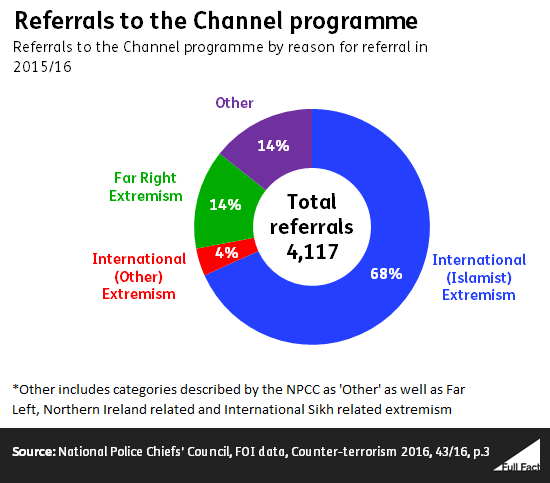What is the Prevent strategy?
Prevent was set up in 2006 by the Labour government as part of the wider counter-terrorism strategy called CONTEST. Prevent’s aim is to stop people becoming terrorists or supporting terrorism.
It was reviewed by the Coalition government in 2011 in order to separate direct counter-terrorism activities from integration work with communities. Integration work would no longer be part of Prevent, according to then Home Secretary Theresa May.
The Prevent strategy has three objectives:
- Challenging the ideology that supports terrorism and those who promote it,
- Protecting vulnerable people,
- Supporting sectors and institutions where there are risks of radicalisation.
Committees of MPs have heard criticisms of the strategy including that it alienates Muslim communities, restricts freedom of expression and impacts human rights. This has been echoed by a number of NGOs. A UN representative also suggested that the Prevent programme was having the opposite of its intended effect by “dividing, stigmatising and alienating segments of the population”.
The government has said the strategy is working and “has made a significant impact in preventing people being drawn into terrorism”.
Prevent is a UK-wide strategy, as counter-terrorism is the responsibility of the UK government. In practice it is delivered differently in the different countries of the UK as many of the organisations involved, for example the police and councils, are under the control of devolved governments. The Prevent strategy is not applied in Northern Ireland.
Under the Prevent strategy organisations like councils and schools develop projects to reduce the risk of people becoming involved in terrorist activity. Around 42,000 people participated in 142 projects in 2015/16, according to government figures.
It also includes things like providing “advice, support, production capabilities and social media training to civil society groups to help deliver counter-narrative campaigns” as well as removing extremist material from the internet. Training and learning materials are also provided to staff in organisations like the schools and the NHS in order to help them recognise radicalisation.
Join 72,953 people who trust us to check the facts
Sign up to get weekly updates on politics, immigration, health and more.
Subscribe to weekly email newsletters from Full Fact for updates on politics, immigration, health and more. Our fact checks are free to read but not to produce, so you will also get occasional emails about fundraising and other ways you can help. You can unsubscribe at any time. For more information about how we use your data see our Privacy Policy.
Channel
A key part of the Prevent strategy is “Channel”. Police work with public bodies, including local councils, social workers, NHS staff, schools and the justice system to identify those at risk of being drawn into terrorism, assess what the risk might be and then develop tailored support for those referred to them. This could range from mentoring to things like anger management or drug and alcohol programmes.
That said “association with organisations that are not proscribed and that espouse extremist ideology is not, on its own, reason enough to justify a referral to the Channel process”, according to the House of Commons Library.
Not everyone referred to Channel will be deemed suitable for the programme—there’s a filtering process in case the person isn’t really at risk of radicalisation, and to weed out referrals that are wrong or malicious. Around 1,000 people have received support through Channel since 2012, according to government figures.

The level of referrals has increased since 2007/08, but this could be linked to the organisations involved being more aware of extremism generally, as well as the different forms it comes in. It could be linked to the police making people more aware that the programme exists, or it could be related to an increase in extremism. There is no way to know.
In 2015 the law was changed to oblige specified public organisations to prevent people being “drawn into terrorism”. This includes councils, the NHS, and schools, as well as police and criminal justice bodies. The government’s guidance on Prevent says that as part of their duty these organisations need to consider whether those at risk should be referred to the Channel programme.
Other counter-terrorism programmes
The government’s overall counter-terrorism strategy has a number of arms in addition to Prevent, according to the House of Commons Library:
- Pursue—its main aim is “to stop terrorist attacks”.
- Protect—“to strengthen our protection against terrorism attack”.
- Prepare—“where an attack cannot be stopped, to mitigate its impact”.